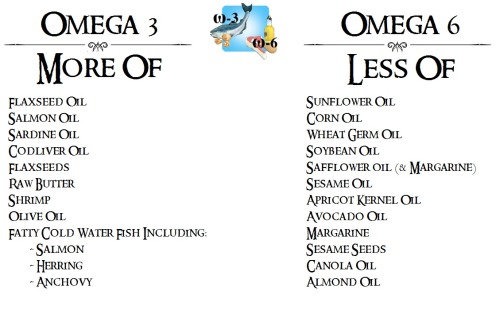Nutritional Tip: The typical Western diet contains much higher quantity of Omega-6 fatty acids than it does Omega-3. For example, the typical Australian diet contains an Omega-6:Omega-3 ratio of around 18:1 (or 18 times as many Omega-6 EFA’s as Omega-3).
Unbeknownst to many, this imbalance of Omega-6 to Omega-3 contributes to the majority of the chronic diseases of high prevalence in Western countries including cardiovascular disease, cancer, and inflammatory and autoimmune diseases. Lowering one’s ratio of Omega-6 / Omega-3 fatty acids is a powerful step in decreasing the risk of many such diseases.
Step 1: Anthropological sources suggest that human’s evolved eating a diet with an ratio of Omega-6 to Omega-3 of 1:1. While it may be difficult to accomplish, a great starting point is to supply your diet with Omega-3 EFA’s containing food and supplements.
Step 2: Simultaneously, reduce your use of the vegetable oils highlighted in the above image and steer clear from junk foods (cooked using vegetable shortening) entirely!
Step 3: Be aware that meat, poultry and dairy that is grown using commercial farming methods will have high Omega 6 / 3 ratio’s. For example, the average supermarket egg has a ratio of 20:1, when compared with organic range fed eggs which have a ratio of 6:3 (or 1.5:1). Where possible, try using organic, raw dairy products as well as sourcing high-quality grass fed beef and poultry to affect further changes to your Omega 3 / 6 ratio.
Reference:
Simopoulos, A. P. (2002). The importance of the ratio of omega-6/omega-3 essential fatty acids. Biomed Pharmacother, 56(8), 365-79.

No comments:
Post a Comment